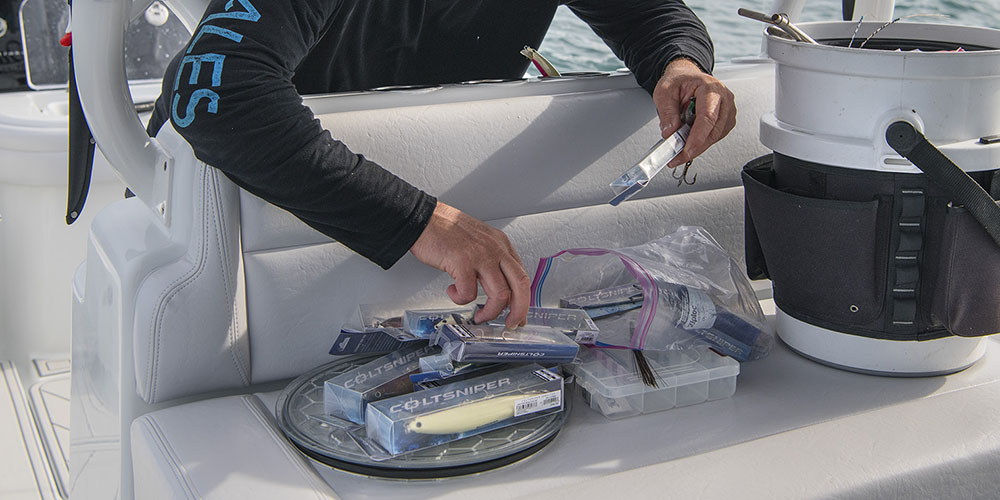
Organized anglers catch more fish!
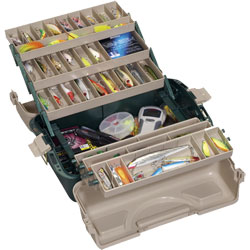
Trunk-style tackle box with three trays.
When the action gets thick, the last thing you want is to waste time fumbling around for whatever jig, lure, or bait is the hot ticket of the day. The hallmark of a competent angler is organization, and well-organized anglers catch more fish. The point of this article is to help you organize your tackle, so that when the bite turns on you can gear up stat.
Depending on how much tackle you have and the type of fishing you enjoy, getting organized can consist of carefully stocking a single tackle box with the tackle you really need, or it can be something more sophisticated, such as one or more soft tackle bags—part of a modular system based on plastic “tackle trays”, each stocked with lures and terminal tackle for specific fishing situations.
Traditional Trunk/Tray Tackle Boxes
Most of us are familiar with trunk/tray tackle boxes, which have a hinged lid that when opened reveals one or more slotted shelves that accordion up and out. Baits, swivels, hooks, sinkers, and other tackle are organized and stored in the shelves while other items, such as fishing reels, spools of line and tools are kept in a larger space underneath. For many anglers, this might be the only storage solution they will ever need, but for others, those who grow and diversify in their fishing pursuits, there is a better way.
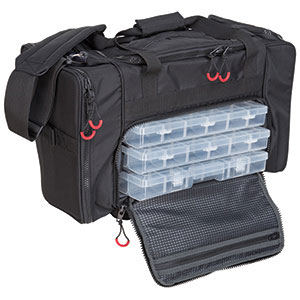
Soft tackle bag with tackle trays.
More on Traditional Tackle Boxes
Traditional tackle boxes work fine when fishing from a stationary location, such as a pier, beach or riverbank, but they have a tendency to slip around, pose a trip hazard and when open, inconveniently spill their contents on a heaving deck. Another problem with traditional tackle boxes is that you end up carting around a lot of stuff that you normally don’t need. Sure, that Tady lure works great when yo-yoing for yellowtail jack, but do you really need it when fishing for surfperch—where a Carolina rig is the order of the day?
And what about anglers that live in coastal areas who might be wacking largemouth one weekend and hammering king mackerel the next? Of course, you can opt for two tackle boxes, which is what some do—but will either box satisfy all your fishing needs? The answer for many is no, especially those of us who fish for a wide variety of species, each with specific tackle requirements. This is why modern, modular systems comprised of one or more soft tackle bags loaded with tackle trays that contain the gear you really need make sense.
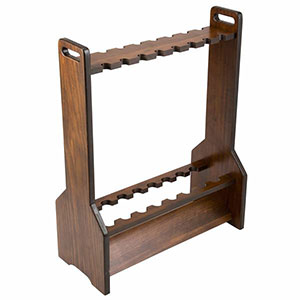
Wood fishing rod racks are an attractive way to store and display your rod collection.
Soft Tackle Bags and Trays
The beauty of soft tackle bags paired with plastic tackle trays is that you can organize “six ways to Sunday,” meaning that regardless of the amount of tackle that you have or the type of fishing you do, a modular solution exists. For example, inshore/offshore saltwater anglers can load separate trays with inshore and offshore gear. If desired, offshore tackle can be further divided into trays for specific species of fish, and you can do the same thing with your inshore gear.
In the case of offshore tackle, you can also create trays for deep-water tackle and trays for surface fishing. These are general examples. How you actually organize your tackle is up to you—but the goal should always be immediate access to the tackle you need. “Tempus fugit” when the bite is on, and wasting time can mean the loss of a fish! Apart from housing tackle trays, most soft tackle bags also include plenty of storage pockets for reels, tools, spools of line and other gear.
On the Boat
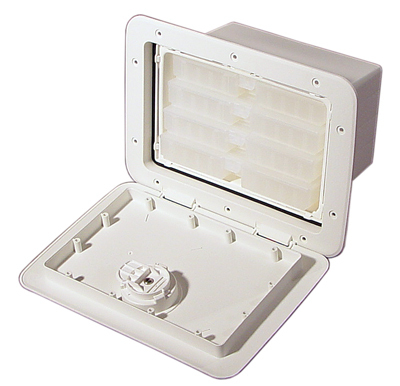
Flush-mount hatches store tackle trays within easy reach.
On your boat, you can work directly out of your tackle bag; however many offshore and inshore boats are now equipped with flush-mount cabinets that accept tackle trays, which keeps them out of the way, but within immediate reach. If you are planning on installing one of these cabinets on your boat, look before you leap, as tackle tray dimensions vary slightly from manufacturer to manufacturer. The goal should be a seamless system, where the trays that you store at home will also fit in your bag, and if your boat is so equipped, also fit into the cabinet on deck.
Jig Storage
Jigs and lures used for billfish and other big offshore game are frequently too large to store in tackle trays. The alternative is to store these lures in a lure wrap or valise—one specifically designed for this purpose. This method of storage gives you the opportunity to organize your offshore lures by size and target species, pre-rigged and ready to go. A bit of advice: When you are done using a jig or lure, never put it away wet!
Wash, Rinse and Dry Used Hooks and Jigs
Nothing makes a mess of stored tackle faster than a saltwater hook or jig that is put away without washing it first and then allowing it to thoroughly dry. Not doing so can result in rust and corrosion “going viral” and ruining every piece of tackle in its path. To prevent this, we suggest you place used lures, hooks and jigs in a bucket. At the end of the day, you can wash these items right along with the boat. Then hang them up and wait until they are absolutely dry before you put them away.
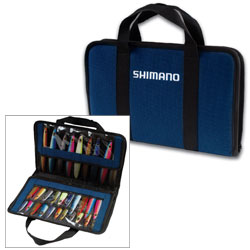
Valise with jigs.
Expect the Unexpected
Organizing your tackle to fish your target species should be number one on your list—but it is also smart to be prepared for other opportunities that might come your way. For example, when fishing deep for grouper, it’s not a bad idea to have a couple of rods rigged and ready with the lures you need, should a school of dorado or other pelagic chance to appear.